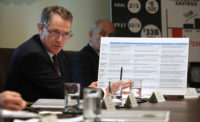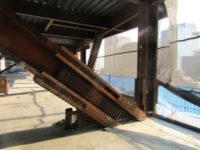On Sept. 30, Canada joined a new trade agreement with the U.S. and Mexico after months of resistance from Prime Minister Justin Trudeau. The renegotiated agreement—USMCA, which replaces NAFTA—follows President Donald Trump’s imposed tariffs on steel and aluminum imports from the neighboring countries.
Despite the new deal, the 25% tariff on imports of steel and 10% on aluminum imposed on Canada and Mexico will continue “until such time we can do something so our steel industry is protected,” Trump said Oct. 1 at a White House press conference. He pointed to quotas on imports of Canadian and Mexican steel and aluminum as an agreement that might lead to ending the tariffs.
Trudeau was less enthused by the deal, but he said in his own press conference in Ottawa that he was satisfied with the progress. “We recognize that moving forward and eliminating the tariffs remains a priority,” Trudeau said. “We’re going to continue discussions on these issues knowing we’ve made good progress and there’s still more work to do.”
Canadian Foreign Minister Chrystia Freeland added that steel and aluminum have always been separate from membership in the NAFTA trade bloc. Mexican Foreign Minister Luis Videgaray told Mexican broadcaster Televisa he believes “it would be a good sign [if] we could resolve this controversy [and conclude a steel deal] before the agreement is signed towards the end of November.”
U.S. Trade Representative Robert Lighthizer told reporters at the White House that the U.S. would be willing to discuss the matter “after we take a few days to catch our breath.”
While the American Iron and Steel Institute, a trade organization that represents U.S. steel manufacturers, lauded the deal, many contractors and engineers trying to plan projects have been hit hard by price increases due to the tariffs.
“We are pleased that the agreement is trilateral, as the relationship between our three countries has been extremely beneficial for the steel industry and resulted in robust trade and investment in the region over the past 25 years,” said Thomas J. Gibson, president and CEO of the institute, in a statement.” The Association of Equipment Manufacturers, which represents more than 1,000 manufacturers, echoed Gibson’s sentiment.
|
Related Link |
Project Costs Rise
One project that has seen costs rise is a planned municipal wastewater treatment plant in Logan, Utah, which has seen its price increase by $25 million over the last year, attributed to what project officials say is both the tariffs and a tight labor market.
Logan city officials and members of the Regional Wastewater Treatment Rate Committee asked the Utah Water Quality Board in late September for a 10-year extension of a loan from the Utah Division of Water Quality to help cover the increased cost without raising rates above those approved in March 2017.
“We don’t have a choice; we’ll have to get it done somehow,” said Mark Nielsen, the city’s senior construction management engineer. He said that extending the loans from 20 years to 30 years and requesting an additional $20 million or $30 million from the department is the only way to cover the unexpected cost increase while keeping rates the same.
In 2016, Carollo Engineers estimated costs of the wastewater treatment plant at $106 million. In June, it increased the estimate to $131 million. Construction manager MWH Constructors agreed to a guaranteed maximum price of $135 million, which includes $4.3 million in contingency.
Nielsen pegged the increase to the plant’s steel requirements and increasing labor costs. “Construction costs have been going up significantly over the past two years,” he said. “We should have built this project two years ago.”
MWH Constructors said that there was not enough project design detail to purchase steel and other materials forward in 2016 when the initial construction estimate came out. With the new estimate issued in April, both labor and materials costs went up.
“The construction scope was set to go out to market with the drawings at 100% design,” said John Kolkman, project manager for MWH Constructors. “When we received the actual subcontracting package equipment pricing it was significantly higher.”
Kolkman said the largest steel package in the project is the amount of rebar necessary for the concrete structures. He also said the difficulty of finding skilled craft labor from all disciplines contributed to the increased costs.
“Obviously, we’ve done some value-engineering by changing some steel components to concrete where we can,” Kolkman said, “but in the last few years it’s a general uptick in the cost of construction that is driving the price of this and other projects we are doing higher.” He also said that MWH believes it can deliver the project for the $135-million maximum if procurement moves along rapidly and construction begins on schedule.
Managing Through
Ryan Moss, project director for McCarthy Building Cos. on the $278-million redesign and reconstruction of Washington University in St. Louis’ Danforth campus, has said that while most structural steel for his project was purchased well in advance, there have been higher costs for specialty steel.
“There were a couple of instances where specialty metals did not get released and/or pricing locked in before the tariffs were in place that we are trying to manage through,” he says. “In these instances, we are seeing anywhere from 10% to 5% cost increases.”
Trump touted the strategy of using tariffs to bring other nations to the negotiating table as something he would continue to use to right what he perceives as trade imbalances. The European Union and Japan have begun discussions with the U.S. on new trade deals, and Trump said similar conversations are getting underway with Indian Prime Minister Narendra Modi.
A New Model?
One quota deal that could serve as a template for Mexico and Canada to get steel tariffs lifted from their exports is the one the administration struck with South Korea in March, in which the Koreans agreed to cut steel exports to the U.S. by 30% of the average for the past three years, in exchange for an indefinite tariff exemption. South Korea then received a quota of about 2.68-million metric tons of steel exports, or 70% of the annual average of Korean steel exports to the U.S. between 2015 and 2017.
The U.S. Dept. of Commerce, on Sept. 20, debuted a new rebuttal system for builders or manufacturers seeking tariff exclusions for products that are not available domestically.
Those requesting exclusions will have seven days to submit rebuttals. Once posted by Commerce, objectors will then have a seven-day period to respond, countering with claims that show those products are available in the U.S.






Post a comment to this article
Report Abusive Comment